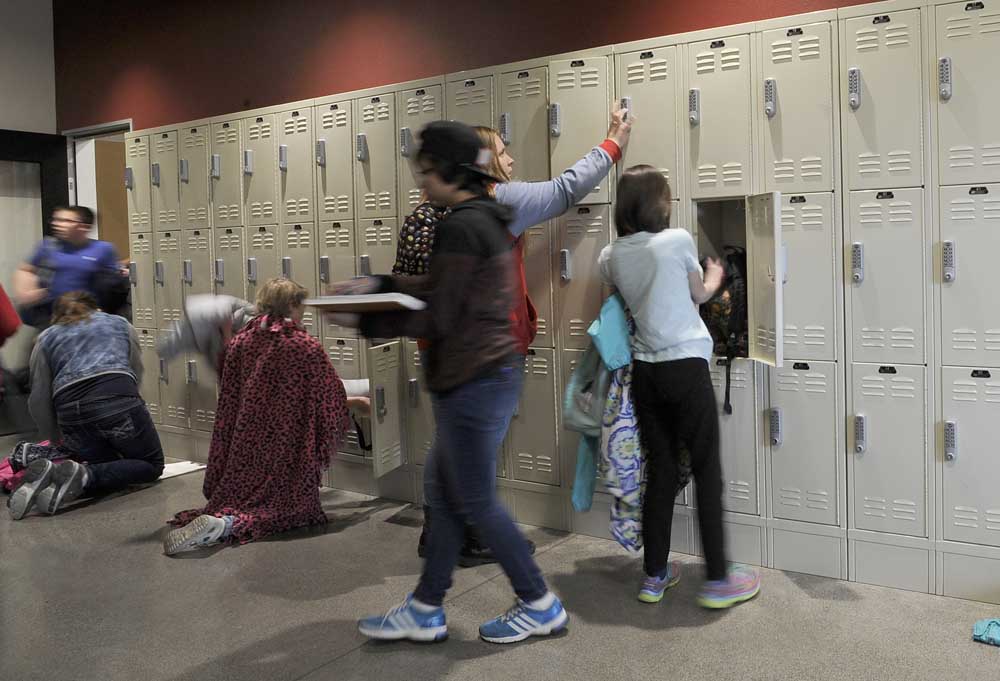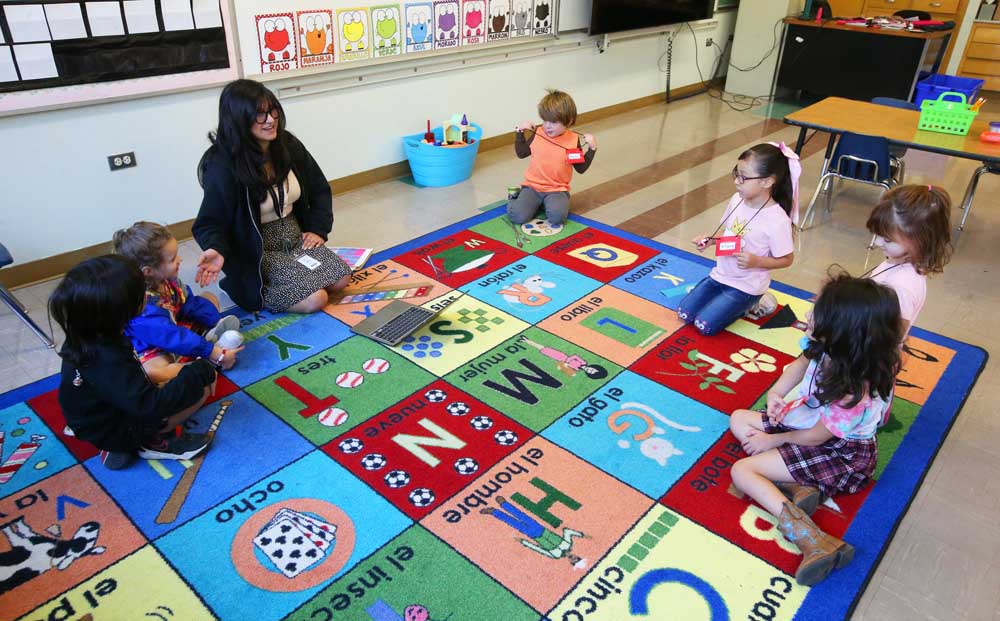School lockers: Student use has changed
Published 12:58 pm Thursday, January 18, 2018

- Redmond Proficiency Academy middle school students collect personal items from temporary day-use lockers shortly after school ends for the day on Friday. (Ryan Brennecke/Bulletin photos)
Depending on where and when you went to high school, lockers put a stamp on your teenage reality — uncool to use and therefore neglected , a convenient spot to stash your stuff or the epicenter of your existence.
Locker use, at least in part, is a social behavior that fluctuates as often as fashion. But lockers also illustrate a larger question Bend-La Pine educators are asking: Are they building schools to meet the needs of today’s students, or are they designing them the same way they always have?
Bend-La Pine Schools is in the design phase of building two schools using part of the $268.3 million bond approved earlier this year, including a comprehensive high school set to open in fall 2021 in southeast Bend for 1,500 to 1,600 students. The school district is set on answering that latter question — of whether educators are building schools the way they always have — with a definitive “no.”
It has assigned design teams — made up of district staff, architects, teachers and principals — to look at what may work best for the schools based on the classes they’ll offer and the students they’ll serve.
While the design of the new elementary school is well on its way, many features of the new high school have yet to be decided, including how to install lockers.
Because there are often not enough lockers for every student, it’s common practice to assign them only to freshmen. But at Bend High, which has had especially high enrollment the past several years, the 420 lockers available aren’t enough to serve its 500 freshmen. Most freshmen, as well as some special needs students, are assigned a locker, according to the school’s principal, Chris Reese.
Older students who drive to school often stash things in their cars, which they are allowed to access at lunch and during five-minute passing periods. Reese said the school asks freshmen to share if possible, so that opens lockers for more students. The rest make do without, hauling backpacks or stashing bags — like those used for athletic practices — in a classroom or an office.
The rollout of technology can also affect locker use. In the district’s high schools, many of the students have electronic textbooks on iPads they receive in the third grade, lightening their load. Still, there are some classes that require textbooks, Reese said, and the school’s library has paper copies of books.
Even with a significant number of e-books downloaded on their iPads, teens have the iPads to carry, perhaps a novel for their English class, maybe one or two textbooks, and other items such as lunches, bike helmets, notebooks, binders and sports equipment.
“I wish we had enough, at least for our freshmen and sophomores,” Reese said.
So did he use a locker in his days at Hillsboro High School?
“You bet,” Reese said, adding that the California design of the open-air campus wasn’t “real conducive” to the Pacific Northwest’s weather. The lockers were outside.
About 20 minutes away at Ridgeview High School in the Redmond School District, Principal Lee Loving said only 6 percent of freshmen used their assigned lockers, according to a poll taken last school year. At that school, the chance of getting a locker is much higher, with 712 lockers and 917 students enrolled in the 2017-18 academic year.
The 263 freshmen were given a locker in the fall, and upperclassmen can request them too, although most don’t, Loving said. The reason the lockers don’t get used is mostly behavioral, Loving said.
“It’s the social aspect,” Loving said. “Everyone wants to see their friends.”
During five-minute passing periods, pressed to choose between catching up with friends or stopping at their lockers, students would rather lug belongings to be able to socialize. Ridgeview students each have a Chromebook laptop, but their textbooks are not electronic, Loving said.
Shayla Weirbach, 18 and a senior at Ridgeview, said there’s not enough time to make it to a locker and get to class on time. Another Ridgeview senior, Zach Jacoby, 17, said he doesn’t use a locker because he doesn’t have much to carry. He doesn’t use notebooks because he skips taking notes. His teachers are OK with that, he said, when they see him acing his tests.
That’s not what leadership encourages at the school, however. Because Ridgeview is part of the college readiness program AVID, or Advancement Via Individual Determination, the school highly encourages taking notes, especially by hand, because that has been shown in research to help students better retain what they’re learning, Loving said. At that school, too, students use their cars to store extra belongings.
It could be at Ridgeview that the use of lockers is sporadic. On a Monday with a bike or skateboard helmet in tow, a locker comes in handy. On Tuesday when a student is driven to school, there’s no need.
At Redmond Proficiency Academy’s middle school campus, the design was created with that kind of use in mind.
The school, part of the Redmond School District, installed about 30 lockers that can be used by any student, any day. Students put their items inside, punch in whatever four-digit code they choose into a keypad, then use that code later to unlock it. The lock then resets itself automatically, so it’s ready for the next user.
The lockers are convenient because students use them when they need them, but they aren’t wildly popular at the school, according to Donna Nordstrom, the school’s executive assistant and college and career coordinator.
“There’s no waiting in line,” Nordstrom said.
Cheri Helt, a Bend-La Pine School Board member serving on the new high school’s design committee, viewed those lockers with district superintendent Shay Mikalson.
In addition to the appeal of the lockers being able to serve multiple students, they are smaller than traditional lockers so that “you could probably put more in the right locations,” Helt said.
“One of my takeaways in the locker discussion is having them in spots where kids will use them,” Helt said.
If they are in an inconvenient location, students won’t use lockers because they can’t make it to them and their classes in time. And if they’re too far away from where students gather to socialize at breaks, they may not be used.
At her Michigan high school, Helt used her locker to store her heavy winter coat and school supplies.
Bend-La Pine’s deputy superintendent Jay Mathisen, who toured a number of high schools to get ideas for Bend’s new high school, said only one didn’t have lockers. He and others have mined district staff’s knowledge of Bend-La Pine kids to help them in the decision making process.
“We know that older kids tend not to use them,” Mathisen said.
Part of that is backpacks — they’re in. When Mathisen was in high school in Indiana, that wasn’t the case. Students used their lockers for storage.
“Backpacks weren’t cool,” Mathisen said, chuckling.
His kids use knapsacks, no problem.
Graduates of the past may have used their lockers religiously, and think of the mini, metal storage units as quintessential to the high school experience. But building a school that’s practical for 2019 and the decades ahead means planners can’t project their personal proclivities, Mathisen said.
“What we’re learning is we’re trending away from that,” Mathisen said of heavy locker use. “It seems to not be what it was for some of us that seem to be maybe more attached.”
— Reporter: 541-383-0325, kfisicaro@bendbulletin.com






